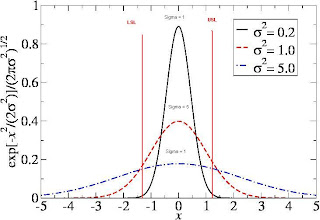An alternate way to look at Six SigmaY = f(X)Here we shall talk about what this straight line function is all abouta and how it leads us to DMAIC.
Y is a function of X. Its value depends on the value assigned to X. Y, thus is dependent, while X is not. Y is called KPOV (Key Process Output Variable). X is called KPIV (Key Process Input Variable).
Y is the output. X is the input. To get results, we should focus on inputs (Xs), not on outputs (Ys). For example, commonly, companies focus on sales target, but not variables / processes that affect the sales target. When variables / processes that control the sales target are identified, and fine tuned, the sales target is automatically brought under control.
Talking in terms of software defects, if all causes of bugs are identified and addressed (all Xs ), then there is no need to test the final product! The final testing can be ignored. Though this is a an idealistic statement, this is what six sigma tries to achieve - reduce the causes of errors so that final inspection can be ignored.
Inspections, manual in particular are never error free. So, no matter how many cycles of review a code undergoes, possibility of error oversight still remains. Therefore, inspections dont really help.
Dell computers for example packages its computer components such that there is no chance of wrong fittings of parts - incompatible system elements would just not fit. Error proofing is done. (Dell call center handlers therefore are confident of letting their customers open the system and repair it as per their instructions given online...)
In software industry, this means modular programming, which yeild good benefits. Modules are pretested, self-containing entities that just need to be integrated and a final system integration test done.
Let us for example say to improve process performance, Eureka Forbes has several Ys to choose from :- Sales, Number of products sold per month, etc. Of them lets consider Sales.
Y = Sales
For this Y, following are the possible Xs
X1 = Product Quality
X2 = Product Features
X3 = Price
X4 = Advertisement Effectiveness
X5 = Sales Force Effectiveness
Of these Xs, lets pick up X5 (Sales force effectiveness) and consider this as Y. Now, for this Y, the possible Xs are:
X1 = Training Effectiveness
X2 = Recruitment and Selection Effectiveness
X3 = Attrition
Next, lets take X1 (Training Effectiveness as Y). For this, the possibel Xs are:
X1 = Trainer Competence
X2 = Duration of Training
X 3 = Training Content
Thus, Y = f (X) helps us in drilling down from output to input to help us select green belt projects. Green belt projects usually have fixed time frame. They have to be chosen such that they are completed well within the time frame. Y = f(X) helps in choosing the Xs, and the corresponding Ys that are dependent on those Xs.
The challenges faced while drilling down for Xs are:
1. Identification of Ys (Which Ys to choose)
2.
a. Measurability of Y
- Current Y
- Target Y
b. Identification of Xs
3. Identification of vital Xs among the identified Ys: Focusing on all Xs may not be yielding. There could be vital Xs whose fine tuning would give results.
4. Improve vital Xs and verify their impact on Y
5. Sustaining the improvements
The above five points are nothing but D-M-A-I-C.
1 = D
2 = M
3 = A
4 = I
5 = C



 This table represents the marks scored in math exam by students in XII-A, XII-B, and XII-C sections. The Q4, Q3, Q2, Q1, and Q0 are the quartiles. In lay terms, the quartiles, divide the range of marks into 4 sections.
This table represents the marks scored in math exam by students in XII-A, XII-B, and XII-C sections. The Q4, Q3, Q2, Q1, and Q0 are the quartiles. In lay terms, the quartiles, divide the range of marks into 4 sections.







